The Ultimate Guide on Soybean Power Drying Sterilizing Machine Continuous Mesh Belt Microwave in 2024
Introduction
Welcome to the forefront of food processing technology in 2024, where the Soybean Power Drying Sterilizing Machine Continuous Mesh Belt Microwave takes center stage. In this comprehensive guide, we delve into the intricate workings of this cutting-edge equipment, designed to revolutionize the soybean processing industry.
The soybean power drying sterilizing machine continuous mesh belt microwave represents a remarkable fusion of advanced technologies tailored to meet the exacting demands of modern food production. By harnessing the power of microwave radiation in a continuous mesh belt system, this machine offers unparalleled efficiency and precision in the drying and sterilization of soybean products.
Gone are the days of traditional drying and sterilization methods that often resulted in uneven processing and compromised product quality. With the continuous mesh belt microwave technology, soybeans undergo a uniform and controlled treatment, ensuring consistent results batch after batch. This not only enhances the safety and shelf life of the final product but also preserves its nutritional integrity and sensory properties.
Furthermore, the continuous operation of this machine streamlines the production process, maximizing throughput while minimizing labor and energy costs. Its automated control systems enable real-time monitoring and adjustment of key parameters, optimizing performance and reducing downtime. This level of efficiency is crucial in meeting the ever-growing demands of the global soybean market.
As we navigate the complexities of food processing in the 21st century, the soybean power drying sterilizing machine continuous mesh belt microwave stands as a beacon of innovation and progress. Join us as we explore its features, applications, and implications for the soybean industry in 2024 and beyond.

Working Principle of Microwave Drying and Sterilization Equipment
The soybean power drying sterilizing machine continuous mesh belt microwave operates on a principle that leverages the unique properties of microwaves to achieve efficient drying and sterilization. Microwaves, which are electromagnetic waves with frequencies between 300 MHz and 300 GHz, interact with the water molecules in soybeans. This interaction causes the water molecules to oscillate rapidly, generating heat through molecular friction.
As the microwaves penetrate the soybeans, they create volumetric heating, which ensures uniform drying and sterilization. This uniformity is crucial for maintaining the quality and nutritional value of the soybeans. The continuous mesh belt system facilitates the movement of soybeans through the microwave field, ensuring consistent exposure and processing.
The controlled environment within the machine allows precise adjustment of parameters such as microwave power, belt speed, and temperature, optimizing the drying and sterilization process. This precise control reduces energy consumption and processing time while ensuring that all pathogens and bacteria are effectively eliminated, making the soybeans safe for consumption and extending their shelf life.
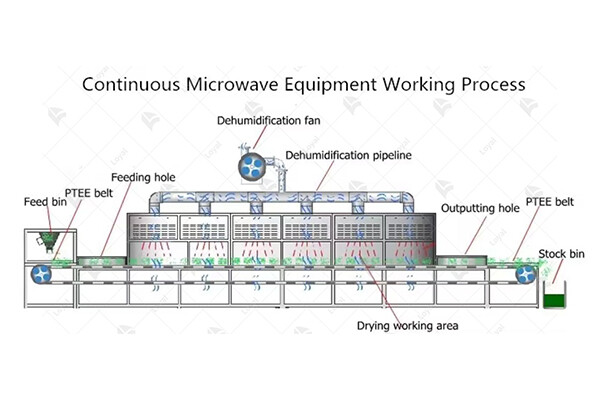
Advantages of microwave drying and sterilization equipment
Advantages | Description |
Efficiency | The soybean power drying sterilizing machine continuous mesh belt microwave offers rapid and uniform drying and sterilization, significantly reducing processing time compared to traditional methods. |
Energy Savings | Microwave technology ensures high energy efficiency by directly interacting with the water molecules in soybeans, leading to reduced energy consumption and lower operational costs. |
Quality Preservation | This equipment preserves the nutritional value and sensory qualities of soybeans, ensuring that taste, texture, and color remain intact throughout the drying and sterilization process. |
Consistent Results | The continuous mesh belt design allows for even distribution and consistent results, ensuring all soybeans are uniformly dried and sterilized, which is critical for maintaining product quality and safety. |
Automation and Control | Advanced control systems enable precise monitoring and adjustments of processing parameters, optimizing performance and minimizing the risk of human error. |
Safety and Compliance | The machine meets stringent food safety standards, ensuring that the soybeans are free from harmful microorganisms and contaminants, complying with global food safety regulations. |
Environmental Sustainability | By reducing the need for chemical preservatives and optimizing energy usage, this microwave drying and sterilization equipment supports environmentally sustainable practices. |
Space Efficiency | The compact design of the soybean power drying sterilizing machine continuous mesh belt microwave saves valuable floor space in processing facilities, making it ideal for both small and large-scale operations. |
Versatility | This equipment is versatile and can be adapted to process various types of soybeans and other food products, making it a valuable asset for food processing businesses looking to diversify their product offerings. |
Reduced Labor Costs | The high degree of automation reduces the need for manual intervention, leading to lower labor costs and allowing staff to focus on other critical aspects of the production process. |
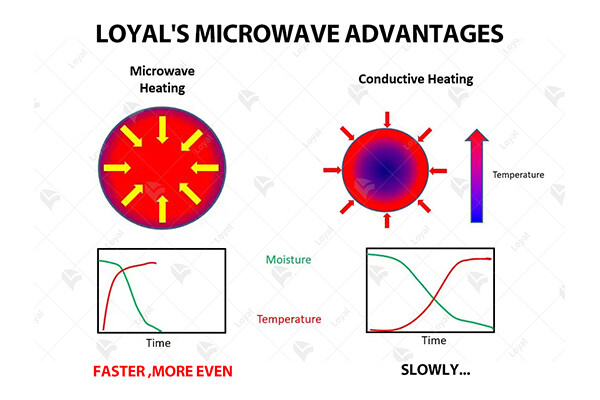
Comparison and advantages of microwave technology and traditional drying methods
Criteria | Microwave Technology | Traditional Drying Methods |
Drying Time | Significantly reduced due to rapid energy transfer. | Longer drying times, often several hours to days. |
Energy Efficiency | High efficiency, as energy is directly transferred to the product. | Lower efficiency, with significant energy loss to the environment. |
Uniformity of Drying | More uniform drying due to even microwave penetration. | Less uniform, often resulting in uneven moisture distribution. |
Temperature Control | Precise control, reducing the risk of overheating. | More challenging to control, higher risk of product damage. |
Nutrient Preservation | Better preservation of nutrients and bioactive compounds. | Higher nutrient loss due to prolonged exposure to heat. |
Operational Footprint | Smaller equipment size, saving valuable floor space. | Larger equipment, requiring more space. |
Labor Requirements | Reduced labor needs due to automation. | Higher labor requirements for monitoring and manual adjustments. |
Environmental Impact | Lower impact, as it is a cleaner and more sustainable technology. | Higher impact due to longer processing times and greater energy use. |
Initial Investment | Higher initial cost, but better ROI due to efficiency and savings. | Lower initial cost, but higher operational costs over time. |
Maintenance | Lower maintenance needs with advanced technology and fewer parts. | Higher maintenance needs due to mechanical wear and tear. |
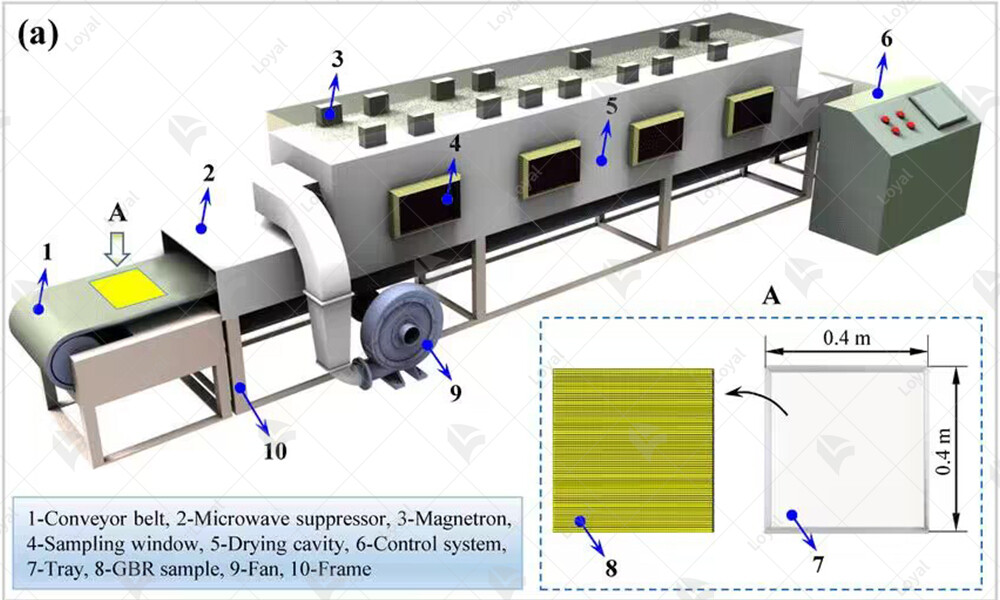
Technical parameters
| Technical Parameters Of Continuous Microwave Dryer Industrial Microwave Drying Machine | |||||
| Model | Size LWH(Can be customized according to the customer's requirements) | Output power | Dewaterability | Sterilization capacity | Baking and Roasting capacity (Depends on different raw material) |
| LY-10KW | 5000mm825mm1750mm | ≥10KW | 10KG/Hour | 100KG/Hour | 30-50KG/Hour |
| LY-20KW | 8000mm825mm1750mm | ≥20KW | 20KG/Hour | 200KG/Hour | 60-100KG/Hour |
| LY-30KW | 8500mm1160mm1750mm | ≥30KW | 30KG/Hour | 300KG/Hour | 90-150 KG/Hour |
| LY-40KW | 10000mm1160mm1750mm | ≥40KW | 40KG/Hour | 40KG/Hour | 120-200KG/Hour |
| LY-50KW | 12500mm1160mm1750mm | ≥50KW | 50KG/Hour | 500KG/Hour | 150-250KG/Hour |
| LY-60KW | 13500mm1450mm1750mm | ≥60KW | 60KG/Hour | 600KG/Hour | 180-300KG/Hour |
| LY-70KW | 13500mm1500mm1750mm | ≥70KW | 70KG/Hour | 700KG/Hour | 210-350KG/Hour |
| LY-80KW | 13500mm1650mm1750mm | ≥80KW | 80KG/Hour | 800KG/Hour | 240-400KG/Hour |
| LY-100KW | 16800mm1650mm1750mm | ≥100KW | 100KG/Hour | 1000KG/Hour | 300-500KG/Hour |
| LY-150KW | 22400mm1850mm1750mm | ≥150KW | 150KG/Hour | 1500KG/Hour | 450-750KG/Hour |
| LY-200KW | 27000mm1850mm1750mm | ≥250KW | 250KG/Hour | 2500KG/Hour | 750-1250/Hour |
| LY-300KW | 32000mm1850mm1750mm | ≥300KW | 300KG/Hour | 3000KG/Hour | 900-1500KG/Hour |
| Power Supply | 380V±10% 50Hz±1% Three-Phase Five-Wire | ||||
| Microwave Output Frequency | 2450±50Mhz | ||||
| Microwave Input Apparent Power | ≤168Kva | ||||
| Microwave Output Power | ≥120Kw | ||||
| Microwave Power Adjustment Range | 0-30Kw(Adjustable) | ||||
| Ambient Temperature | -5-40°C | ||||
| Relative Humidity | ≤80%, Surrounding Environment:No Corrosive Gas, Conductive Dust And Explosive Gas | ||||
| Transmission Speed | 0-10m/Min(Adjustable) | ||||
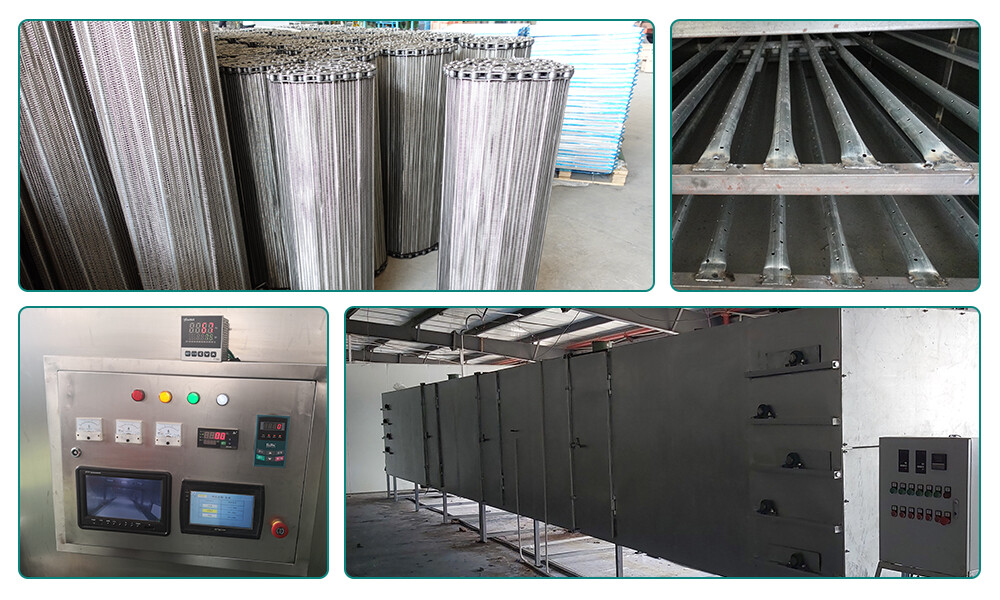
Types of Microwave Drying and Sterilization Equipment
Microwave drying and sterilization equipment has revolutionized the food processing industry, particularly in the handling of soybean products. The most prominent types include:
1. Batch Microwave Drying and Sterilizing Machines: These machines are ideal for small-scale operations and pilot testing. They provide precise control over drying and sterilizing processes, ensuring consistent quality.
2. Continuous Microwave Drying and Sterilizing Machines: Designed for large-scale industrial use, these machines operate on a continuous mesh belt system, offering high throughput and efficiency. The continuous mesh belt microwave system ensures uniform exposure to microwaves, optimizing the drying and sterilization of soybean products.
3. Hybrid Microwave Systems: Combining microwave technology with other drying methods such as hot air or vacuum drying, these systems enhance efficiency and product quality. They are particularly effective in preserving the nutritional value and sensory attributes of soybean products.
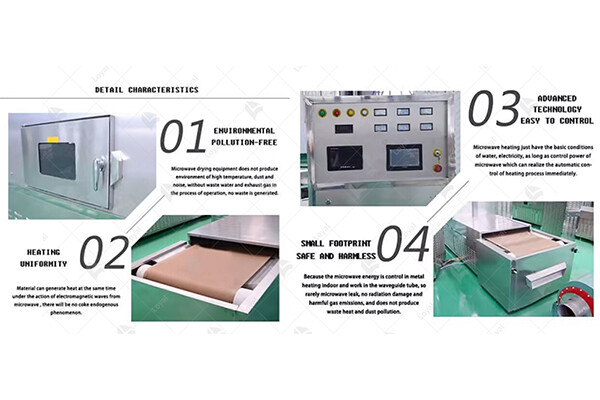
Application of Microwave Drying and Sterilization Equipment
The soybean power drying sterilizing machine continuous mesh belt microwave is a versatile piece of equipment that finds applications across various sectors of the food industry in 2024. Its primary applications include:
1. Soybean Processing: Ensures efficient drying and sterilization, preserving the nutritional integrity and extending the shelf life of soybean products.
2. Spices and Herbs: Provides uniform drying and effective sterilization, maintaining the flavor and potency of spices and herbs.
3. Nuts and Seeds: Achieves consistent drying and sterilization, preventing microbial contamination and rancidity.
4. Fruit and Vegetable Processing: Enhances the safety and quality of dried fruits and vegetables, crucial for consumer health.
5. Meat and Seafood: Offers rapid and thorough sterilization, essential for high-risk perishable items to meet stringent food safety standards.
6. Pharmaceutical Ingredients: Utilized for drying and sterilizing sensitive pharmaceutical components, ensuring product efficacy and safety.
These applications demonstrate the machine's broad utility and essential role in modern food processing, contributing to both product quality and safety.
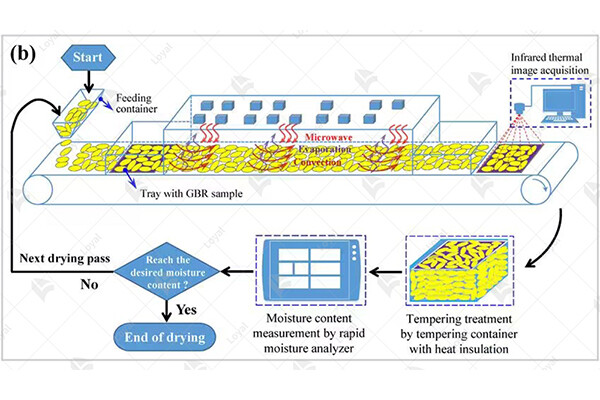
Precautions for the Selection and Implementation of Microwave Drying and Sterilization Equipment
When selecting and implementing a Soybean Power Drying Sterilizing Machine Continuous Mesh Belt Microwave in 2024, several crucial precautions must be taken to ensure optimal performance and safety.
1. Assessing Equipment Compatibility: Ensure the chosen machine is compatible with your specific soybean processing requirements. The equipment should be capable of handling the volume and type of soybeans you process.
2. Quality and Certification: Verify that the machine meets industry standards and certifications. High-quality equipment should be compliant with food safety regulations and possess relevant certifications.
3. Energy Efficiency: Consider the energy consumption of the microwave drying and sterilizing machine. Energy-efficient models will reduce operational costs and support sustainable practices.
4. Control Systems: Look for advanced control systems that allow precise monitoring and adjustment of the drying and sterilization process. This ensures consistent product quality and optimal operational efficiency.
5. Maintenance and Support: Ensure that the manufacturer provides adequate maintenance support and spare parts availability. Regular maintenance is crucial for the longevity and reliability of the machine.
6. Safety Features: Prioritize equipment with robust safety features to protect operators and prevent accidents. This includes emergency shut-offs, thermal sensors, and protective barriers.
By considering these precautions, you can ensure that the Soybean Power Drying Sterilizing Machine Continuous Mesh Belt Microwave will be a valuable asset to your production line, enhancing both efficiency and product quality.
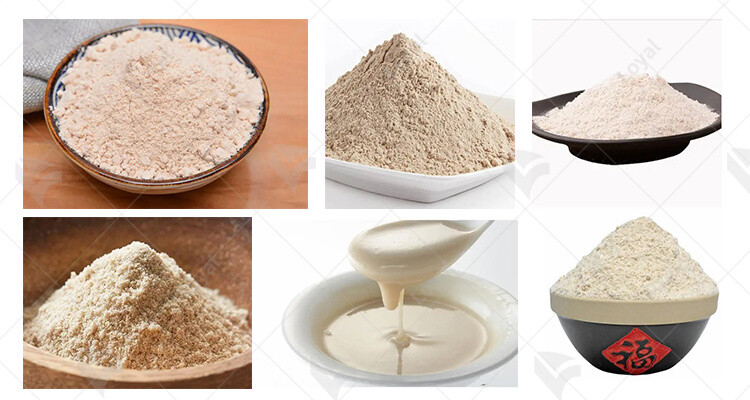
Challenges and limitations of microwave drying and sterilization equipment
Microwave technology has revolutionized the food processing industry, offering efficient drying and sterilization solutions for a wide range of products, including soybeans. However, despite its numerous benefits, microwave drying and sterilization equipment face several challenges and limitations that need to be addressed for optimal performance.
One of the primary challenges of microwave drying and sterilization equipment is uneven heating. Unlike conventional methods, where heat is evenly distributed, microwaves tend to heat certain areas more than others due to variations in moisture content and density within the product. This uneven heating can result in inconsistent product quality and compromised safety standards.
Another challenge is the limited penetration depth of microwaves. While microwaves can penetrate several centimeters into the product, they may struggle to reach the innermost layers of dense or thick materials. This limitation can prolong processing times and increase energy consumption, impacting the overall efficiency of the equipment.
Moreover, microwave drying and sterilization equipment require precise control and monitoring to ensure optimal results. Factors such as power level, exposure time, and product temperature must be carefully regulated to prevent overheating and maintain product integrity. However, achieving this level of control can be challenging, especially when processing large batches or heterogeneous materials.
Furthermore, the cost of microwave drying and sterilization equipment can be prohibitive for some food processors. While the initial investment may be justified by long-term savings in energy and labor costs, smaller operations may struggle to afford the upfront expenses. Additionally, ongoing maintenance and servicing requirements can further add to the overall cost of ownership.
Despite these challenges and limitations, advancements in microwave technology continue to drive innovation in the food processing industry. Manufacturers are constantly developing new techniques and equipment designs to overcome these obstacles and improve the efficiency and reliability of microwave drying and sterilization processes.
In conclusion, while microwave drying and sterilization equipment offer numerous benefits for food processing applications, they also face several challenges and limitations that need to be addressed. By understanding these challenges and investing in technological advancements, food processors can maximize the potential of microwave technology and achieve optimal results in soybean processing and beyond.
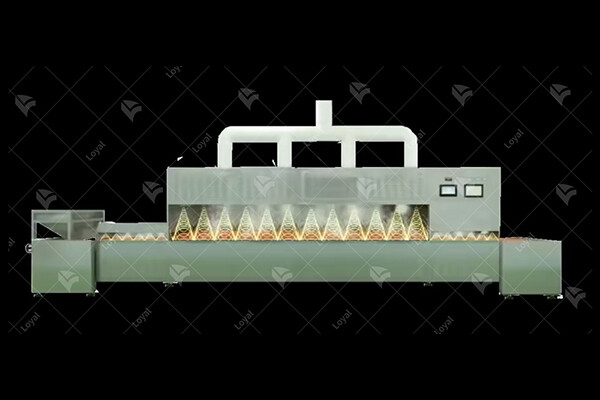
References
1. Food Engineering Magazine: (www.foodengineeringmag.com)
2. Food Processing: (www.foodprocessing.com)
3. Institute of Food Technologists (IFT):(www.ift.org)
4. European Hygienic Engineering & Design Group (EHEDG): (www.ehedg.org)
 Telephone :+86-531-55583139
Telephone :+86-531-55583139 WhatsApp :+86 13256674591
WhatsApp :+86 13256674591 Email :
Email :










